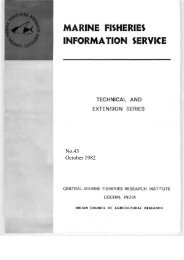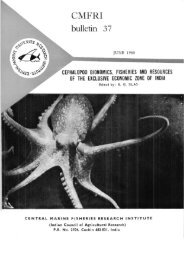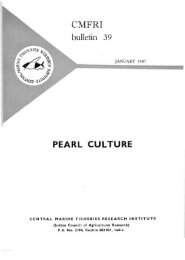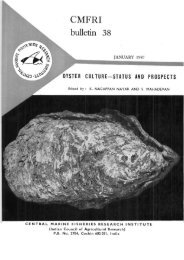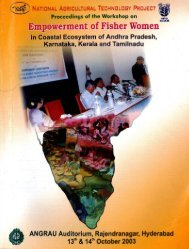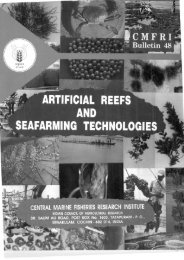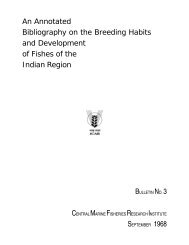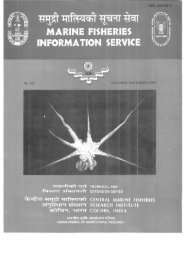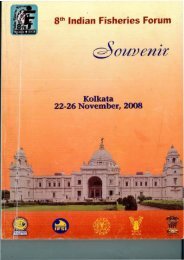Know the Master of the Arabian Sea - CMFRI Utilization strategy for ...
Know the Master of the Arabian Sea - CMFRI Utilization strategy for ...
Know the Master of the Arabian Sea - CMFRI Utilization strategy for ...
You also want an ePaper? Increase the reach of your titles
YUMPU automatically turns print PDFs into web optimized ePapers that Google loves.
<strong>Know</strong>...<br />
The <strong>Master</strong> <strong>of</strong> <strong>the</strong> <strong>Arabian</strong> <strong>Sea</strong><br />
PURPLE-BACK FLYING SQUID<br />
S<strong>the</strong>noteuthis oualaniensis<br />
K. Sunil Mohamed, Geetha Sasikumar, K.P. Said Koya,<br />
V. Venketesan, V. Kripa, R. Durgekar, Ma<strong>the</strong>w Joseph,<br />
P.S. Alloycious, Ragesh Mani and D. Vijai<br />
Central Marine Fisheries Research Institute<br />
Kochi<br />
www.cmfri.org.in<br />
1
<strong>Know</strong>...<br />
The <strong>Master</strong> <strong>of</strong> <strong>the</strong> <strong>Arabian</strong> <strong>Sea</strong>-<br />
PURPLE-BACK FLYING SQUID<br />
S<strong>the</strong>noteuthis oualaniensis<br />
Published by:<br />
Central Marine Fisheries Research Institute<br />
P.O. Box 1603, Kochi - 682 018, Kerala, India<br />
Phone : +91 484 2394867<br />
Fax : +91 484 2394909<br />
Email : mdcmfri@md2vsnl.net.in<br />
Website : www.cmfri.org.in<br />
Citation:<br />
K. S. Mohamed, G. Sasikumar, K.P. Said Koya, V. Venketesan, V. Kripa,<br />
R. Durgekar, M. Joseph, P.S. Alloycious, R. Mani and D. Vijai (2011).<br />
<strong>Know</strong>... The <strong>Master</strong> <strong>of</strong> <strong>the</strong> <strong>Arabian</strong> <strong>Sea</strong> - Purple-Back Flying Squid<br />
S<strong>the</strong>noteuthis oualaniensis, NAIP Booklet, Central Marine Fisheries<br />
Research Institute, Kochi - 682 018, India 20 p.<br />
©2011 Central Marine Fisheries Research Institute, Kochi.<br />
For more in<strong>for</strong>mation on oceanic squids login to<br />
http://www.oceanicsquids.naip.org.in<br />
Printed at<br />
Niseema Printers and Publishers,<br />
Kochi - 682 018,<br />
Phone : 0484-2403760<br />
2
Contents<br />
Introduction ................................................................................. 4<br />
Morphology & Anatomy .............................................................. 5<br />
Population structure .................................................................... 7<br />
Life Cycle .................................................................................... 8<br />
Squid Diets - What do <strong>the</strong>y eat?............................................... 12<br />
Predators - Who eats <strong>the</strong>m? .................................................... 14<br />
Reproduction & Spawning ........................................................ 16<br />
Fishery & Stock abundance...................................................... 18<br />
Acknowledgements .................................................................. 20<br />
3
Introduction<br />
S<strong>the</strong>noteuthis oualaniensis (Lesson, 1830) commonly known<br />
as <strong>the</strong> Indo-Pacific purple-back flying squid, is a true ocean<br />
dweller widely distributed in <strong>the</strong> equatorial and tropical waters <strong>of</strong><br />
Indo-Pacific region.<br />
Global distribution pattern <strong>of</strong> S. oualaniensis<br />
The oceanic squids unlike <strong>the</strong> neretic squids have a pelagic<br />
lifestyle in <strong>the</strong> open ocean and are rarely encountered in <strong>the</strong><br />
commercial catches from inshore waters. The squid is<br />
characterized by a wide ecological amplitude, complex intraspecific<br />
structure, high growth rate, high fecundity, short life cycle, high<br />
natural mortality, and significant production. These large oceanic<br />
squids completely monopolize <strong>the</strong> trophic niche <strong>of</strong> <strong>the</strong> top predators<br />
in <strong>the</strong> Arabina <strong>Sea</strong> and <strong>the</strong>re<strong>for</strong>e is known as <strong>the</strong> <strong>Master</strong> <strong>of</strong> <strong>the</strong><br />
<strong>Arabian</strong> <strong>Sea</strong>.<br />
4
Morphology & Anatomy<br />
The oceanic squids are one <strong>of</strong> <strong>the</strong> most highly developed<br />
invertebrates, adapted to an active predatory life. Body <strong>of</strong> <strong>the</strong> squid<br />
comprise <strong>of</strong> <strong>the</strong> head, mantle and fins along <strong>the</strong> sides. Head consist<br />
<strong>of</strong> eight arms arranged in pairs and two long tentacles. The animal<br />
moves in water by jet propulsion, by taking water into its mantle cavity<br />
and <strong>the</strong>n expelling it with great <strong>for</strong>ce. In oceanic squids, unlike coastal<br />
squids eyes are without any protective membrane and are surrounded<br />
by free eyelids. Large eyes are an important adaptation that helps<br />
<strong>the</strong>se animals locate food in <strong>the</strong> darkness <strong>of</strong> <strong>the</strong> deep ocean.<br />
Body colouration <strong>of</strong> S. oualaniensis under normal condition is<br />
red-brown along <strong>the</strong> dorsal part with large oval luminous photophoric<br />
patch on anterodorsal surface <strong>of</strong> mantle. The colouration changes in<br />
a moment with excitation. The skin is covered with chromatophores,<br />
which enables <strong>the</strong> squid to change colour to suit its surroundings.<br />
They have complex nervous system and highly developed brain.<br />
5
Ink sac<br />
Gills<br />
Nidamental<br />
gland<br />
Ink sac<br />
Gills<br />
Needham<br />
sac<br />
Oviduct with<br />
ripe eggs<br />
Ovary<br />
Testis<br />
Female anatomy<br />
Male anatomy<br />
Adult S. oualaniensis have a muscular funnel; robust mantle<br />
which has a cylindrical anterior and conical posterior half. Fins<br />
are large, rhombic, and muscular, with a blunt back end; <strong>the</strong>ir<br />
width is 70 to 85% <strong>of</strong> mantle length, length 40 to 50% <strong>of</strong> mantle<br />
length; males have wider fins than females; a large, oval<br />
photophore on <strong>the</strong> dorsal side <strong>of</strong> mantle is common which serves<br />
to attract prey.<br />
6<br />
Reddish or purple colour <strong>of</strong> S. oualaniensis
Population Structure<br />
S<strong>the</strong>noteuthis oualaniensis have a complex population<br />
structure that incorporates three major <strong>for</strong>ms.<br />
1) A giant <strong>for</strong>m that occurs only in <strong>the</strong> nor<strong>the</strong>rn Indian Ocean<br />
in <strong>the</strong> region <strong>of</strong> <strong>the</strong> Red <strong>Sea</strong>, Gulf <strong>of</strong> Aden and <strong>Arabian</strong> <strong>Sea</strong> (modal<br />
sizes <strong>of</strong> 40-50 cm mantle length in <strong>the</strong> <strong>Arabian</strong> <strong>Sea</strong>, maximum<br />
size <strong>of</strong> 65 cm mantle length).<br />
2) A middle <strong>for</strong>m, is <strong>the</strong> “typical” one (modal sizes <strong>of</strong> 12-15 cm<br />
<strong>for</strong> mature males and 19-25 cm <strong>for</strong> mature females) that occurs<br />
throughout <strong>the</strong> range <strong>of</strong> <strong>the</strong> species.<br />
3) A dwarf <strong>for</strong>m (modal size <strong>of</strong> 9-10 cm mantle length <strong>for</strong> mature<br />
males and 9-12 cm mantle length <strong>for</strong> mature females, 14-15 cm<br />
mantle length maximum) that occurs in equatorial waters and lacks<br />
<strong>the</strong> dorsal mantle photophore patch characteristic <strong>of</strong> <strong>the</strong> species.<br />
Typical harvest length and weight range observed in <strong>the</strong> <strong>Arabian</strong> <strong>Sea</strong><br />
Fishing Method Lengths (cm) Weights (g)<br />
Jigging 10-25 50-650<br />
Gillnetting 20-35 300-1800<br />
7
Life Cycle<br />
Generally, females grow faster than males. The duration <strong>of</strong><br />
life cycle in dwarf <strong>for</strong>m <strong>of</strong> S. oualaniensis is estimated as 6 months<br />
and middle-sized as well as giant <strong>for</strong>ms as one year. The largest<br />
daily increment in length in <strong>the</strong> middle-sized <strong>for</strong>m is 1.0 mm, while<br />
in <strong>the</strong> giant female it is 3.8 mm. The monthly production <strong>of</strong> 1 year<br />
old giants are 9 times that <strong>of</strong> middle-sized squids <strong>of</strong> <strong>the</strong> same<br />
age.<br />
S. oualaniensis live in <strong>the</strong> water column undergoing diel vertical<br />
migrations up to 1000 m depths. Larvae are planktonic, juveniles<br />
are <strong>of</strong>ten associated with <strong>the</strong> continental slope. They avoid <strong>the</strong><br />
bottom <strong>of</strong> <strong>the</strong> sea even in day time. In <strong>the</strong> continental slope area,<br />
while <strong>the</strong>y descend to <strong>the</strong> near-bottom layer, <strong>the</strong>y remain 2-3 m<br />
away from <strong>the</strong> bottom.<br />
The <strong>for</strong>m, and structure <strong>of</strong> squid mantle, arms, funnel and<br />
fins, <strong>the</strong>ir changes during ontogeny characterize <strong>the</strong>se squids as<br />
powerful swimmers <strong>for</strong> which high horizontal speed is important<br />
8
than maneuverability. In general, movements are characterized<br />
by high cruising speed (3-10 km/h; ML 15-35 cm) and high rush<br />
speed/ burst swimming (25-35 km/h). Maximal locomotory activity<br />
is inherent in young animals <strong>of</strong> ML 3-10 cm. Juvenile S<strong>the</strong>noteuthis<br />
can reach such high speeds that <strong>the</strong>y can leap out <strong>of</strong> <strong>the</strong> water<br />
and fly some distance in <strong>the</strong> air (with tail first). During <strong>the</strong> flight,<br />
S. oualaniensis extends thin protective membranes on <strong>the</strong> III arms<br />
and use <strong>the</strong>m as a second fin (functioning as caudal fin).<br />
Locomotory activity decreases strongly in large squids <strong>of</strong> ML<br />
greater than 45-50 cm.<br />
Vertical distributions change during growth. In <strong>the</strong> <strong>Arabian</strong> <strong>Sea</strong><br />
giant <strong>for</strong>ms have been observed between 400-1100 m depths in<br />
<strong>the</strong> daytime which migrate to 50 to 150 m at night time. In contrast,<br />
medium sized females have been observed at 50-200 m in <strong>the</strong><br />
day and at depths <strong>of</strong> 0-100 m in <strong>the</strong> night. The middle sized <strong>for</strong>m<br />
and young squids occur near <strong>the</strong> surface. Medium sized<br />
S. oualaniensis (27 cm) <strong>of</strong>ten do not <strong>for</strong>m schools.<br />
12 16 20 24 4 2<br />
0<br />
12<br />
26<br />
100<br />
22<br />
200<br />
17<br />
(Depth m)<br />
300<br />
400<br />
500<br />
600<br />
700<br />
800<br />
900<br />
1000<br />
1100<br />
1 2<br />
12<br />
9<br />
8<br />
7<br />
6<br />
6<br />
6<br />
5<br />
5<br />
Temperature (°C)<br />
Vertical distribution <strong>of</strong> S. oualaniensis; 1 - Isolated individuals<br />
2 - High density<br />
9
Depths occupied by this species are low in oxygen.<br />
S. oualaniensis has a very high metabolic rate (standard<br />
metabolism <strong>of</strong> 348 ml O 2<br />
/kg/h) that exceeds that <strong>of</strong> many fast<br />
swimming oceanic fishes. Common with o<strong>the</strong>r squid species,<br />
energy metabolism is based mostly on protein: however, in S.<br />
oualaniensis, during metabolism a considerable proportion <strong>of</strong> <strong>the</strong><br />
protein is catabolised anaerobically, thus enabling <strong>the</strong>se squid to<br />
inhabit zones <strong>of</strong> very low oxygen concentration.<br />
Studies suggest that <strong>the</strong> fishing ground <strong>of</strong> squid was closely<br />
related to <strong>the</strong> marine environmental variables such as SST, sea<br />
surface height (SSH), wind, chlorophyll a and zooplankton. The<br />
optimum SST <strong>of</strong> <strong>the</strong> fishing ground is 25-28°C. Most high-yield<br />
fishing grounds were distributed in <strong>the</strong> waters near sea surface<br />
height anomalies, SSHA
Graphic representation <strong>of</strong> oceanic squid life cycle showing influence <strong>of</strong> environmental factors<br />
11
Squid Diets - What do <strong>the</strong>y eat?<br />
Fast growth rates and high metabolism indicate <strong>the</strong><br />
requirement <strong>of</strong> high food intake. S. oualaniensis is an active<br />
predator with a wide food spectrum varying geographically as well<br />
as with mantle lengths.<br />
In <strong>the</strong> stages <strong>of</strong> paralarvae and early juveniles, <strong>the</strong> squid mainly<br />
predate on crustaceans. Young feed mainly on amphipods,<br />
euphausiids and fish larvae. On <strong>the</strong> fishing ground <strong>of</strong> high daily<br />
catch (over 5 tonnes), zooplankton mainly consists <strong>of</strong><br />
Chaetognatha (average biomass <strong>of</strong> 9.18 mg/m), Copepoda<br />
(2.32 mg/m) and Mysidacea (1.38 mg/m). These three species<br />
were also found in <strong>the</strong> stomachs <strong>of</strong> squid and could be<br />
considered as indicator species <strong>for</strong> a squid fishing ground. In<br />
<strong>the</strong> <strong>Arabian</strong> <strong>Sea</strong>, <strong>the</strong> squid <strong>of</strong> larger than 20 cm ML fed mainly<br />
on small flying fish. As <strong>the</strong> size <strong>of</strong> squid increased, <strong>the</strong> smaller<br />
squids S. oualaniensis became progressively more important<br />
in <strong>the</strong> diet and by 40 cm ML, squids comprised more than 50%<br />
<strong>of</strong> <strong>the</strong> diet (extreme cannibalism).<br />
Oceanic Squid<br />
Flying fish<br />
12
Early juveniles are active-grazing predators, late juveniles and<br />
middle-sized squids are predator-pursuers, while large-sized adults<br />
are attacking predators. Never<strong>the</strong>less, <strong>the</strong> giant females <strong>of</strong><br />
S. oualaniensis in <strong>Arabian</strong> <strong>Sea</strong> consume mainly myctophids, which<br />
are numerous and inactive in <strong>the</strong> layer 100-200 m, hence <strong>the</strong>y<br />
remain as active-grazed predators instead <strong>of</strong> large nektonic<br />
predators.<br />
13
Predators - Who eats <strong>the</strong>m?<br />
The early juveniles and paralarvae <strong>of</strong> squids are <strong>the</strong> prey <strong>for</strong> a<br />
wide variety <strong>of</strong> predators including small squids, large chaetognaths,<br />
jellyfishes, carnivorous fishes etc. Squid juveniles from 3-10 cm<br />
are prey to large squids, tunas (skipjack tuna, yellowfin tuna, wahoo,<br />
bigeye tuna) dolphin fish, snake mackerel (Gempylus serpens),<br />
lancet fish and small sharks. Main predators <strong>of</strong> middle-sized squids<br />
are dolphins, swordfish and some active species <strong>of</strong> sharks. Largesized<br />
squids are inaccessible <strong>for</strong> tunas and <strong>the</strong>y have fewer<br />
predators: adult swordfishes, dolphins, too<strong>the</strong>d whales and large<br />
sharks. A variety <strong>of</strong> studies indicated <strong>the</strong> presence <strong>of</strong> S. oualaniensis<br />
in <strong>the</strong> stomach <strong>of</strong> various predators.<br />
In <strong>Arabian</strong> <strong>Sea</strong>, large oceanic predators rarely occur, <strong>the</strong>re<strong>for</strong>e<br />
<strong>the</strong> oceanic squids, owing to its high abundance, large size, short<br />
life span, fast growth and high food ration almost completely<br />
monopolize <strong>the</strong> trophic niche <strong>of</strong> <strong>the</strong> top predators. Hence, <strong>the</strong>y<br />
are called as <strong>the</strong> <strong>Master</strong> <strong>of</strong> <strong>the</strong> <strong>Arabian</strong> <strong>Sea</strong>.<br />
Some <strong>of</strong> <strong>the</strong> major predators <strong>of</strong> S. oualaniensis are given on page 15.<br />
14
Reproduction & Spawning<br />
In S. oualaniensis sexes are separate. Female reproductive<br />
organs consist <strong>of</strong> ovary, with thin walled as well as glandular<br />
portions; <strong>the</strong> paired nidamental glands and seminal receptacles.<br />
Ripe eggs are pinkish or raspberry coloured. Males have a unilobed<br />
testis and <strong>the</strong> male genital duct is a white, fluid-filled sac in <strong>the</strong><br />
posterior end <strong>of</strong> <strong>the</strong> mantle. Sperms are stored in thin tubes<br />
(spermatophores) in an elongated sac behind and along <strong>the</strong> left<br />
gill.<br />
There is indirect evidence that S. oualaniensis is a multiple<br />
spawner where intermittent spawning occurs over an extended<br />
period. Spawning lasts <strong>for</strong> 1-3 months at a relatively stable level<br />
without a decrease in feeding rate, with significant growth. The<br />
frequency <strong>of</strong> spawning episodes within this period are unknown.<br />
Accumulation <strong>of</strong> eggs in <strong>the</strong> oviducts is a continuous process.<br />
Spawning is not linked to <strong>the</strong> bottom and occurs in epipelagic<br />
zones. Spermatophores are stored <strong>for</strong> a long period in seminal<br />
Spawning ground <strong>of</strong> oceanic squids located in <strong>the</strong> <strong>Arabian</strong> <strong>Sea</strong><br />
16
eceptacles on <strong>the</strong> buccal membranes in females consequent to<br />
mating. Potential fecundity depends on <strong>the</strong> adult female size<br />
varying from 0.3 to 22 million eggs and relative fecundity ranges<br />
from 3,000- 7,000 oocytes per g body weight.<br />
Egg masses <strong>of</strong> S. oualaniensis consist <strong>of</strong> a translucent mucus<br />
in which many pale crimson eggs <strong>of</strong> 0.72-0.86 mm are dispersed<br />
at a density <strong>of</strong> about 1-2 eggs/cm 3 (maximal volume <strong>of</strong> 25 l).<br />
In S. oualaniensis, spawning grounds have been located in<br />
<strong>the</strong> seas around Lakshadweep Islands during post-monsoon. After<br />
<strong>the</strong> spawning period, juveniles are abundant in <strong>the</strong> surface waters<br />
at densities ranging from 0.5 to 1.8 million numbers/km 2 (See map<br />
below).<br />
Map showing juvenile abundance near Lakshadweep Islands<br />
during post-monsoon period<br />
17
Fishery & Stock Abundance<br />
The purple-back flying squids are distributed in open oceans<br />
and are ra<strong>the</strong>r scattered; this has impeded <strong>the</strong>ir commercial<br />
exploitation. In <strong>the</strong> North Pacific, historic fishing activity <strong>for</strong><br />
S. oualaniensis occurred predominantly <strong>of</strong>f Okinawa, Taiwan,<br />
Vietnam and Hawaii where it is dip-netted or jigged at<br />
<strong>the</strong> surface during day and night. The species supports<br />
local fisheries from June to November in Okinawa and from<br />
March to November in Taiwan, with peak fishing from May to<br />
August.<br />
China has successfully exploited some important oceanic<br />
squids since 1989 from around <strong>the</strong> world. In 2005, a small-scale<br />
Chinese commercial jigging fishery <strong>for</strong> S. oualaniensis started in<br />
<strong>the</strong> <strong>Arabian</strong> <strong>Sea</strong>, yielding more than 5000 t in production. Fishing<br />
18<br />
Composite abundance map <strong>of</strong> oceanic squid S<strong>the</strong>noteuthis<br />
oualaniensis in <strong>the</strong> <strong>Arabian</strong> <strong>Sea</strong> during 2010-11
occurs predominantly by automated jigging using lights to attract<br />
<strong>the</strong> squid. India is now making attempts to tap this resource and a<br />
composite fishery abundance map is shown on page 18. These<br />
are results <strong>of</strong> planned jigging surveys carried out during 2010-11.<br />
The main period <strong>of</strong> abundance is <strong>for</strong> 6 months from October to<br />
March with peak during December - January.<br />
The stock abundance <strong>of</strong> S. oualaniensis has been worked<br />
out based on scientific surveys in <strong>the</strong> <strong>Arabian</strong> <strong>Sea</strong> during 2010-11<br />
and rendered in GIS <strong>for</strong>mat. Many areas between <strong>the</strong><br />
Lakshadweep Islands show abundance in excess <strong>of</strong> 5 tonnes/<br />
km 2 during <strong>the</strong> post and pre-monsoon periods.<br />
The total stock <strong>of</strong> S. oualaniensis in <strong>the</strong> world’s ocean is<br />
estimated to be between 8-11 million tonnes. Studies indicates<br />
that S. oualaniensis dominates <strong>the</strong> epipelagial zone <strong>of</strong> <strong>the</strong><br />
<strong>Arabian</strong> <strong>Sea</strong> both in number and biomass and that <strong>the</strong> mean<br />
biomass is estimated as 4.5 t km -2 . The most promising region<br />
<strong>for</strong> a large-scale fishery <strong>of</strong> S. oualaniensis is <strong>the</strong> <strong>Arabian</strong> <strong>Sea</strong><br />
with <strong>the</strong> fishable stock estimated as between 1.0 and 1.5 million<br />
tonnes.<br />
19
Acknowledgements<br />
We are grateful to <strong>the</strong> funding support received from National<br />
Agricultural Innovation Project (NAIP) <strong>of</strong> <strong>the</strong> Indian Council <strong>of</strong><br />
Agricultural Research (ICAR), New Delhi through <strong>the</strong> Project<br />
‘<strong>Utilization</strong> <strong>strategy</strong> <strong>for</strong> Oceanic squids (Cephalopoda) in <strong>Arabian</strong><br />
<strong>Sea</strong>: A Value Chain Approach’.<br />
We are also thankful to <strong>the</strong> Director, <strong>CMFRI</strong>, Kochi <strong>for</strong> <strong>the</strong><br />
facilities.<br />
20




